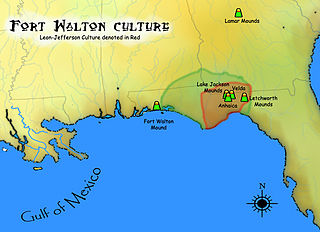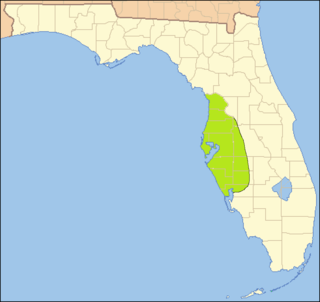Related Research Articles

Ceramics of Indigenous peoples of the Americas is an art form with at least a 7500-year history in the Americas. Pottery is fired ceramics with clay as a component. Ceramics are used for utilitarian cooking vessels, serving and storage vessels, pipes, funerary urns, censers, musical instruments, ceremonial items, masks, toys, sculptures, and a myriad of other art forms.

Lake Jackson Mounds Archaeological State Park (8LE1) is one of the most important archaeological sites in Florida, the capital of chiefdom and ceremonial center of the Fort Walton Culture inhabited from 1050–1500. The complex originally included seven earthwork mounds, a public plaza and numerous individual village residences.

The Weeden Island cultures are a group of related archaeological cultures that existed during the Late Woodland period of the North American Southeast. The name for this group of cultures was derived from the Weedon Island site in Old Tampa Bay in Pinellas County.

The Fort Walton culture is the term used by archaeologists for a late prehistoric Native American archaeological culture that flourished in southeastern North America from approximately 1200~1500 CE and is associated with the historic Apalachee people.

The Leon-Jefferson Culture is the term used by archaeologists for a protohistoric Native American archaeological culture that flourished in southeastern North America from approximately 1500–1704 CE and is associated with the historic Apalachee people. It was located in and named for the present day Leon and Jefferson counties in northern Florida of the Southeastern United States
The Big Mound Key-Boggess Ridge Archeological District is a historic site near Placida, Florida. It is located southeast of Placida, on Big Mound Key. On December 3, 1990, it was added to the U.S. National Register of Historic Places.

The Fort Walton Mound (8OK6) is an archaeological site located in present-day Fort Walton Beach, Florida, United States. The large platform mound was built about 850 CE by the Pensacola culture, a local form of the Mississippian culture. Because of its significance, the mound was designated a National Historic Landmark in 1964.
The St. Johns culture was an archaeological culture in northeastern Florida, USA that lasted from about 500 BCE until shortly after European contact in the 17th century. The St. Johns culture was present along the St. Johns River and its tributaries (including the Oklawaha River, and along the Atlantic coast of Florida from the mouth of the St. Johns River south to a point east of the head of the St. Johns River, near present-day Cocoa Beach, Florida. At the time of first European contact, the St. Johns culture area was inhabited by speakers of the Mocama, Agua Fresca and Acuera dialects of the Timucua language and by the Mayacas.

The Kincaid Mounds Historic Site c. 1050–1400 CE, is a Mississippian culture archaeological site located at the southern tip of present-day U.S. state of Illinois, along the Ohio River. Kincaid Mounds has been notable for both its significant role in native North American prehistory and for the central role the site has played in the development of modern archaeological techniques. The site had at least 11 substructure platform mounds, and 8 other monuments.

The Safety Harbor culture was an archaeological culture practiced by Native Americans living on the central Gulf coast of the Florida peninsula, from about 900 CE until after 1700. The Safety Harbor culture is defined by the presence of Safety Harbor ceramics in burial mounds. The culture is named after the Safety Harbor site, which is close to the center of the culture area. The Safety Harbor site is the probable location of the chief town of the Tocobaga, the best known of the groups practicing the Safety Harbor culture.

Mississippian culture pottery is the ceramic tradition of the Mississippian culture found as artifacts in archaeological sites in the American Midwest and Southeast. It is often characterized by the adoption and use of riverine shell-tempering agents in the clay paste. Shell tempering is one of the hallmarks of Mississippian cultural practices. Analysis of local differences in materials, techniques, forms, and designs is a primary means for archaeologists to learn about the lifeways, religious practices, trade, and interaction among Mississippian peoples. The value of this pottery on the illegal antiquities market has led to extensive looting of sites.
The Beaverdam Creek Archaeological Site,, is an archaeological site located on a floodplain of Beaverdam Creek in Elbert County, Georgia approximately 0.8 km from the creek's confluence with the Savannah River, and is currently inundated by the Richard B. Russell Lake. The site consisted of a platform mound and an associated village site.

Kʼaxob is an archaeological site of the Maya civilization located in Belize. It was occupied from about 800 B.C. to A.D. 900. The site is located in northern Belize in the wetlands of Pulltrouser Swamp in proximity to the Sibun River Valley in central Belize. Research has shown that Kʼaxob was occupied from the Late Preclassic Period to the Early Postclassic Period. This period in time and the site is characterized by specific ceramic types as well as agriculture and an increase in social stratification. Kʼaxob is a village site centered on two pyramid plazas and later grew in size during the Early Classic Period to the Late Classic Period. The site includes a number of household, mounds and plazas. Kʼaxob is mostly based on residential and household living but also has some ritualistic aspects.

The Manasota culture was an archaeological culture that was practiced on the central Gulf coast of the Florida peninsula from about 500 BCE until about 900, when it developed into the Safety Harbor culture. From about 300 to 700 the Manasota culture adopted the ceremonial ceramics and burial practices of the Weeden Island cultures of northern Florida and adjacent Alabama and Georgia.
The Mill Cove Complex is a group of prehistoric archaeological sites located in Duval County, Florida built by people of the St. Johns culture approximately 900 to 1250 CE. The site encompasses two sand mounds, Grant Mound (8DU14) and the contemporaneous Shields Mound (8DU12) located 750 metres (0.47 mi) away, and an area in between the two which is full of St. Johns culture midden deposits.
Cayo Pelau Archaeological Site is a multi-period aboriginal archaeological site in Charlotte Harbor on the west peninsular Gulf coast of the United States. The island is 3.5 miles directly south of the Big Mound Key-Boggess Ridge Archeological District. It is the only site that lies within two counties, Lee County in the south and Charlotte County, Florida to the north. Neither county has taken responsibility for identifying, protecting or preserving the prehistoric and historical cultural resources on the island.
The Griesmer site (La-3) is located on the Kankakee River in Lake County, Indiana, about a mile southeast of Schneider, in Northwestern Indiana. It is classified as a Prehistoric, multi-component site with Middle Woodland, Late Woodland and Upper Mississippian occupations. The deposits were not stratified, but observation of the types of artifacts present, together with radiocarbon dates, helped to define the sequence of occupations at the site.
The Gentleman Farm site is located in LaSalle County, Illinois, on the Illinois River. It is a multi-component site with the main occupation being a Langford tradition component of Upper Mississippian affiliation.
The Fisher Mound Group is a group of burial mounds with an associated village site located on the DesPlaines River near its convergence with the Kankakee River where they combine to form the Illinois River, in Will County, Illinois, about 60 miles southwest of Chicago. It is a multi-component stratified site representing several Prehistoric Upper Mississippian occupations as well as minor Late Woodland and Early Historic components.
The Roberts Island complex is an archaeological site in Citrus County, Florida, near the Gulf of Mexico, dating from the late Woodland period. It is located on an island in the Crystal River midway between the springs at the head of the river and the mouth of the river on the Gulf of Mexico. The site is a geographically separate unit of the Crystal River Archaeological State Park. The site includes three shell mounds and three middens. Two of the mounds may have had stepped sides. The Roberts Island complex was developed as the Crystal River site declined and most other ceremonial sites in the region were abandoned during the 7th or 8th century.
References
- ↑ Mitchem, Jefferey M. (1989). Redefining Safety Harbor: Late Prehistoric/Protohistoric Archaeology in West Peninsular Florida (Thesis). Gainesville, Florida: University of Florida. p. 252–255.
- 1 2 Luer, George M. (2002). "The Aqui Esta Mound:Ceramic and Shell Vessels of the Early Mississippian-Influenced Phase". Tallahassee, Florida: Anthropological Publication No.15.
{{cite journal}}: Cite journal requires|journal=(help) - ↑ Cordell, Ann S. (March–June 2005). "Revisiting the Aqui Esta Mound (8CH68): Paste Variability in the Pottery Assemblage". The Florida Anthropologist. 58 (1–2): 105–120 – via University of Florida Digital Collections.
- ↑ Byers, Martin A. (2018). The Real Mound Builders of North America: A Critical Realist Prehistory of the Eastern Woodlands 200 B.C. -1450 A.D. New York, New York: Lexington Books.
